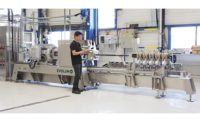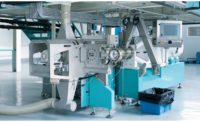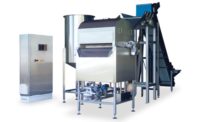Snack manufacturers are looking to build in healthfulness through the use of raw materials, including vegetables and fruit, as well as cleaner ingredient profiles with more protein and fiber. Puffed and extruded snacks can meet these needs in unique and forward-trending ways using new and updated extrusion equipment.
Equipment manufacturers have responded to market demands with twin-screw machines, hot air expanders and pre-conditioners that improve snacks through improved stability, flexibility and customized design, as well as better temperature, texture and color control.
Extrusion trends
Clextral, Firminy, France, has been among those experiencing a building interest in nontraditional raw materials for snack applications. These can include vegetables and fruits, and local, non-GMO and organic ingredients, says Gilles Maller, vice president of sales and international.
“We see more and more snacks which are a mix of corn and raw materials—green peas, onions, tomatoes—even though it may not constitute a main part of the recipe,” Maller says. “We see more and more exotic raw materials, organic most of the time. During development, we work closely with spice and flavor companies to match the topical seasoning with the base.”
Maller also sees filled snacks as a growing trend. “Processors can use their existing extruders and integrate different ancillaries to give them flexibility to make different products,” he says.
Baker Perkins, Peterborough, England, has seen increased demand for extruded snacks with more protein and fiber. “Gluten-free is another category seeing rapid growth,” says Keith Graham, marketing manager. “Extrusion can help manufacturers respond to demand by using flours from gluten-free grains such as maize, rice, quinoa or buckwheat, and also provide grain-free products by using vegetables and legumes.”
The company has noted greater interest in twin-screw extrusion technology, which can bring significant savings in space, equipment, energy and labor, while enabling flexible switching among different recipes, such as bread crumbs, croutons and gluten-free bread products, Graham says.
Extruders can be used to cut cracker-type snacks from a thin, wide sheet of dough into regular, geometric shapes using an in-line rotary cutter, Graham notes. “This creates a low-fat alternative to conventional frying,” he says. “Using extruders to make sheeted snacks taps into a trend for thinner snacks—plenty of crunch, but less product and, hence, fewer calories.”
Reading Bakery Systems, Robesonia, PA, has been hearing greater interest from its customers in low-pressure extrusion to create filled, extruded shapes. Snacks filled with peanut butter are the biggest draw, says Vincent Pasquini, pretzel and snack technical sales engineer. “That market, you can’t get enough of,” he says. “That’s big for us right now, as well as the variations of flat products.”
Customers of Reading Bakery all seem to want to do their own unique shapes, Pasquini notes. “It’s not the ‘me-too’ thing,” he says. “And our customers are also driving us toward cleaner designs and more sanitary materials, with plastics vs. heavier steel parts for ease of cleaning and better ergonomics.”
Bühler Group, Plymouth, MN, has seen a wave of customers wanting to develop popped snacks with “interesting and unique raw materials,” says Mike Shaw, sales account manager, snacks and cereals, North America.
Popped pellet snacks are growing from niche to mainstream, notes Shaw. “You might have seen a few that use air popping,” he says. “But the medium and bigger guys, snack and cereal companies, are realizing that this is an inexpensive way to launch new products.”
Customers of Egan Food Technologies, Grand Rapids, MI, are typically looking for a custom-built solution for a specific extrusion application that’s automated but affordable, says Mike Bond, sales manager. “We’ve been able to engineer solutions that affordably achieve their automation goals through modular systems that grow with our customers,” he says. “In some cases, we may suggest that customers invest in auxiliary equipment to improve their processes instead of an entirely new line.”
New equipment to match
Clextral has responded to these trends by rolling out a line of twin-screw extruders known as Evolum, with several new models during the past few years, most recently including the Evolum 44+ for snacks and breakfast cereals, Maller says. The Evolum+ platform offers greater temperature control, overall quality, process stability and more.
“Our equipment platform is very versatile,” says Maller. “It’s able to process different materials and also offers a hygienic design to allow for simplified cleaning. So, when you make a product change, you limit cross-contamination and downtime. We see people adding different shapes, different raw materials, and then wanting quick changeover from one product to another.”
The Evolum offers 20 percent to 40 percent greater capacity than previous machines while improving end-user control, Maller notes. “This machine has the ability to run multiple raw materials,” he says. “As recipes get more complex, the more benefits are achieved through the advanced processing capabilities of the twin-screw extruder.”
Baker Perkins has announced a new design for the SBX Master twin-screw extruder, for snacks and other applications, with a preconditioner added to increase flexibility. The SBX Master features simplified design for mounting the die and cutter to improve changeover, cleaning and maintenance speed, and safety. “The die is supported on a hinged arm that enables it to be moved quickly and safely, especially when hot, while the cutter slides in and out of position on rails,” Graham says. “The flexibility of the extruder has been improved by increasing power, torque and speed. This, along with a range of barrel lengths, increases the variety of end products that can be made.”
The preconditioner boosts flexibility when applied to denser materials like half products formed in the extruder and expanded elsewhere, such as flaked, puffed snacks. The machine mixes, hydrates and heats wet and dry ingredients, plus steam, in a two-chamber system, Graham says. “The first stage inputs energy in a high-intensity mixing phase; the second allows the energy and moisture to equalize throughout the preconditioned mass, eliminating any tendency to clump and achieving the optimum mix profile for successful extrusion.”
Reading Bakery Systems has been further developing its Series 7 high-speed extruder with various types of auger profiles to produce a range of product shapes, Pasquini says. These improvements have been designed “to create less pressure or more pressure, to be a little more efficient, as well as one-piece plastic sanitary designs that can be removed, taken to a wash basin and cleaned,” he says. The company has also upgraded the pre-feed rolls to gain more-accurate piece-weights, he says. “That’s important for the baking process, because inconsistency results in different moisture and/or color.”
Bühler Group has responded to customers’ desires to develop better-for-you, air-popped products with the AeroExpander, a new technology for continuous indirect pellet expansion that delivers hot air and provides an efficient, consistent process. The company says the product delivers tight control of the expansion, as well as density, color and texture. Nozzles blow hot air down onto the product, and the heat transfer through the airflow causes the pellets to pop, Shaw says. Snack and cereal companies can purchase pellets in the shape they want, pop and expand them, and then add seasoning to create “healthy new products with interesting shapes,” he says.
Bühler’s customers are using raw materials like chickpeas, beans, other protein sources, and ancient grains, Shaw says, and the company gives them the option to pilot test either at its own facility or by renting a machine. “We give them the support to test different pellet products, which allows them to run different types of raw materials,” he says.





